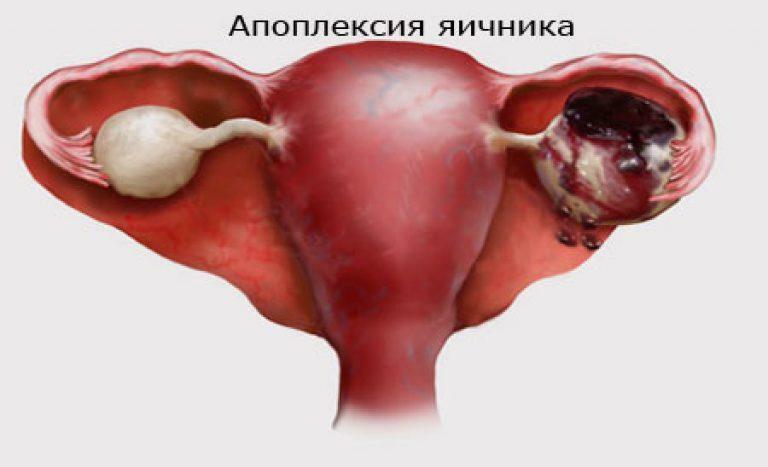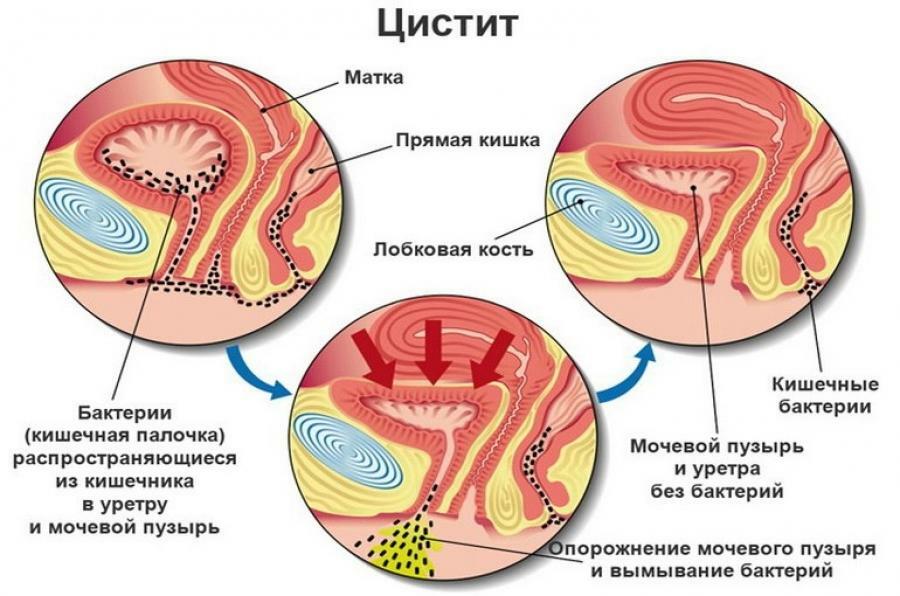Children with cerebral palsy, or cerebral palsy, are often referred to as other children, or simply angels. According to statistics, about 120 thousand people suffer from this serious illness in our country, not counting those who have not been diagnosed accurately. But in 75% of patients, violations associated with cerebral palsy are well amenable to correction - the main thing is to notice signs of the disease in time and to start adequate therapy. How can we recognize infantile cerebral palsy at the very beginning of a baby's life?

Cerebral palsy in newborns: symptoms
Content of material
- 1 What is cerebral palsy?
- 2 Causes and risk factors
- 3 How to determine cerebral palsy in newborns?
- 4 Types of cerebral palsy
- 4.1 Video - Cerebral palsy. Symptoms, signs and methods of treatment
- 5 Diagnosis of cerebral palsy
- 6 At what age can cerebral palsy be diagnosed?
- 6.1 Video - Reflexes Moro and reflexes of support
- 7 Treatment of cerebral palsy
What is cerebral palsy?
CP is not an isolated disease, but a whole complex of CNS lesions that affect one or more brain regions. As a result, the child is disrupted muscle activity, coordination of movements and motor functions, there are problems with hearing, speech, psychomotor development, intellect suffers. The main feature of cerebral palsy is that the disease does not belong to the progressive, that is, it can and should be treated.
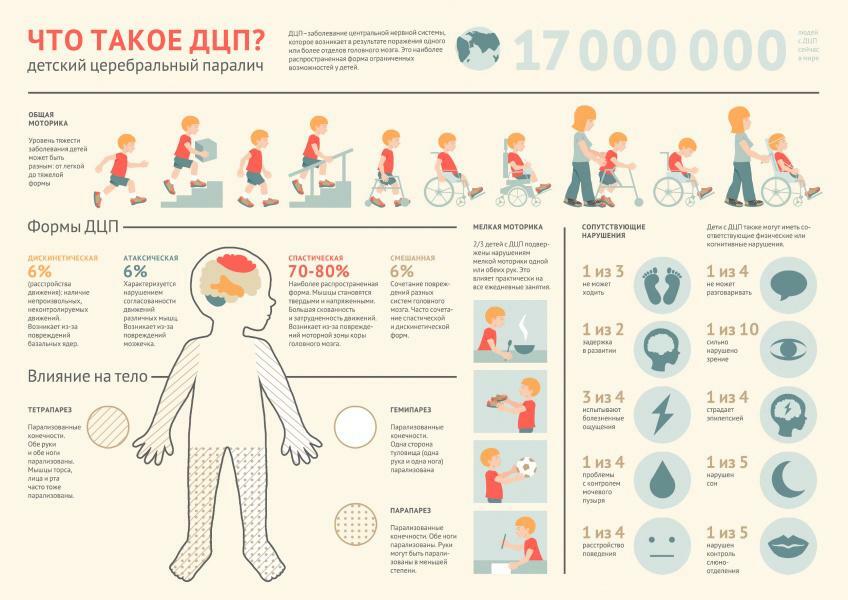
What is Cerebral Palsy
Causes and Risk Factors
The causes of the central nervous system of the child and the development of cerebral palsy can be many, but the main factors include the following.
- Complications during pregnancy. Nerve cells of the baby begin to form already from the first weeks, and the key period in the formation of the central nervous system is the period from 10 to 18 weeks. Defects of the nervous system can cause chronic diseases of the mother( heart diseases, diabetes, hypertension), severe toxicosis, food and chemical poisoning, exposure to radiation, etc.
- Genetic disorders. Mutations in chromosomes doctors call one of the factors that affect the development of cerebral palsy. The exact mechanism for the development of such disorders is unknown, so any malfunction in the genetic apparatus of parents can lead to the disease.
- Intrauterine infections. Among the diseases that can have a negative impact on the child's brain, include rubella, chlamydia, cytomegalovirus, herpes, mycoplasmosis, ureaplasmosis. Among other things, they can cause placenta, which causes the fetus to lack oxygen and nutrients.
- Complications of delivery. Complex delivery, prolonged anhydrous period, cord cord entanglement, mechanical trauma of the fetus - all this leads to hypoxia and, accordingly, damage to the fetal brain.
- Premature delivery. According to statistics, 40-50% of patients with cerebral palsy were born prematurely, and many of them were on the ventilator. Such children are most susceptible to CNS and brain lesions - in healthy, full-term babies, even in the presence of hypoxia, blood is distributed so that all parts of the brain function normally. In preterm, weakened children, this ability is absent, so their brains suffer from a lack of oxygen particularly strongly.
- Hemolytic disease. This phenomenon occurs when a complex conflict between the Rh factor of the mother and child, as well as with protracted jaundice of newborns( bilirubin has a toxic effect on the brain cells).
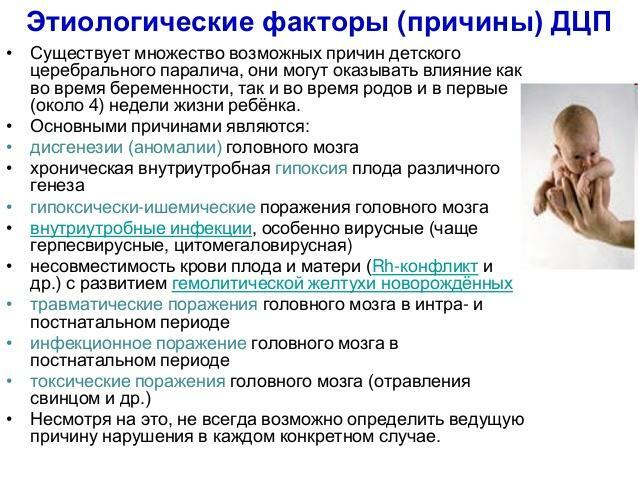
Etiological factors of cerebral palsy
The presence of one or more of the above factors does not always lead to the development of cerebral palsy. If the lesions are minimal, the case may be limited to the diagnosis of PER( perinatal encephalopathy), but even such children require increased attention of parents and doctors.
How to determine cerebral palsy in newborns?
It is possible to notice the symptoms of cerebral palsy right after the birth of the child, but the final diagnosis should be made exclusively by a specialist. What are the signs that require special attention and immediate medical attention?
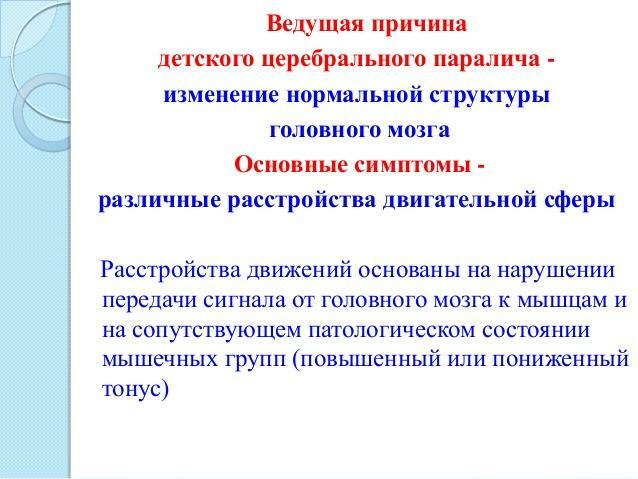
Why there is cerebral palsy
- Presence of one or more risk factors during the period of fetal or delivery.
- Violation of the norms of development. There are certain periods when the kid should be able to hold the head, turn over, sit down, keep objects - a serious lag behind this schedule should seriously alert the mother. For example, if at four months the child does not turn his head toward the outgoing sound or reaches for the toy, it should be consulted as soon as possible with a specialist.
- Violation of psychoemotional development. Psycho-emotional development of the baby also fits into certain norms: in a month he should learn to smile, in 2 - to make sounds, etc. This factor also plays an important role in the diagnosis of cerebral palsy.
- Violation of muscle tone. Children are born with hypertension syndrome, which disappears by a certain time. At 1.5 months, hypertension of the upper limbs disappears, in 3-4 months the muscle tone of the lower extremities decreases. If this does not happen, you can suspect the development of cerebral palsy and other diseases. Hypotonus muscles( "rag" limbs) is also an alarming sign.
- Asymmetry of the body. The muscles and limbs of a healthy child develop symmetrically, and any violation of this symmetry requires a more thorough examination. For example, the so-called fencer's pose, when one toddler handle is bent and tense, and the second is relaxed and loosely along the body. There is also an asymmetry of movements - it consists in the fact that the baby moves better and more actively than the other with one limb. There may be different thicknesses of pens and legs, which is very important to notice in a timely manner.
- Violent Movements. This phenomenon is observed in the majority of patients with cerebral palsy. Such movements are always involuntary and come in several forms: sharp, fast twitching of the lower extremities or slow, wavy movements of the feet and hands. They have the property to increase in stressful situations, at rest their activity decreases, and during sleep they completely disappear.
- Frequent child anxiety. Children never cry for no reason - if the baby is not hungry, dry and does not suffer from colic, he will not scream. Frequent causeless crying, poor sleep and anxiety can be signs of various diseases, including cerebral palsy.
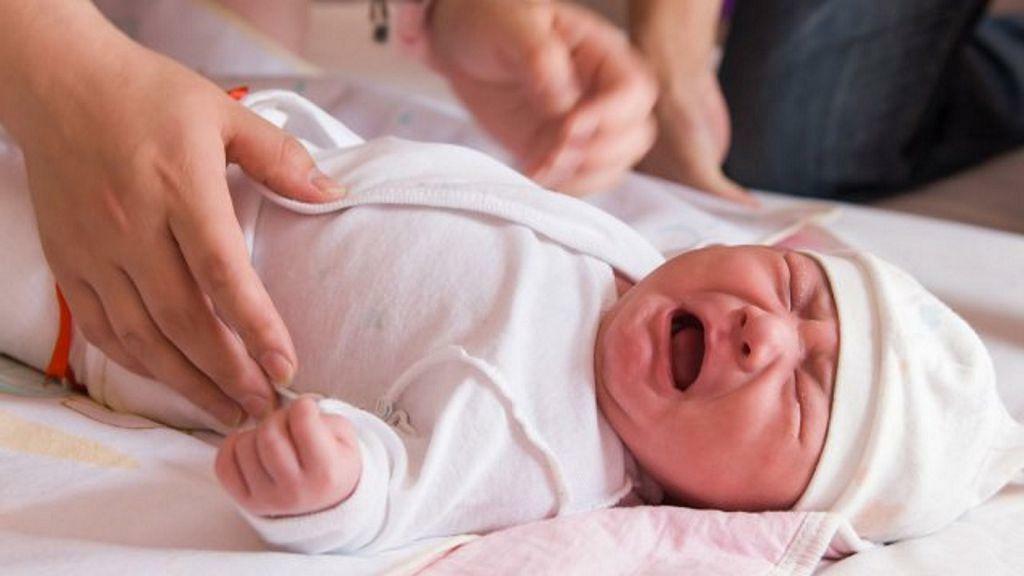
Frequent unreasonable anxiety of the child can signal the presence of the child's cerebral palsy
- convulsive syndrome. Some mothers encounter cramps in children at high temperature. In addition, the convulsive syndrome is manifested by flinch, tremor and sudden stop of the look.
- Manifestations from the skin, eyes and other organs and systems. Symptoms of developing cerebral palsy often include marbling or cyanosis of the skin, excessive sweating, unexpectedly arising strabismus and asymmetry of the pupils, constant popperation.
It should be noted that such symptoms can be not only a symptom of cerebral palsy, but also point to other diseases, and in some cases they are the physiological norm or individual features of the development of the baby - only the specialist will say more precisely after a detailed study.
Types of cerebral palsy
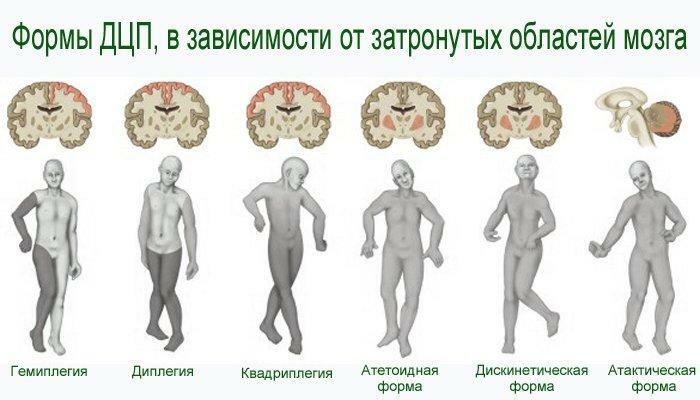
Forms of cerebral palsy, depending on the affected areas of the brain
Children's cerebral palsy has many manifestations, so doctors distinguish several types of this disease. Each of them is characterized by certain changes in the brain and the disorder of certain organs or systems.
| Syndrome Brain lesions | Symptoms | |
|---|---|---|
| Spastic diplegia | Foci of death, the presence of neoplasms | Disturbance of the limbs, most often the lower limbs( the hands fully or partially retain functionality).In the legs there is an increased muscle tone, crawling with the hands of the baby, but pulling up his legs, practically not moving them. The baby begins to walk later, with the support under the mouse crosses his legs. Intellect and speech in most patients are preserved, children can serve themselves |
| Spasmodic tetraplegia | Multiple foci of death and developmental defects, white matter damage of the hemispheres | Dysfunction of the swallowing function, hypertension of all limbs( on the one hand it can be expressed more), impaired motor activity, often - epilepsy, defects of mental development. Such children remain mentally retarded throughout life. |
| Hemiplegia | Usually cerebral hemorrhages | Dysfunction of limbs on the one hand, most often on the right. In the first months after birth, it may be unnoticeable, but afterwards the symptoms become pronounced. One hand can be constantly twisted and pressed against the body, a convulsive syndrome is noted. Such children on time or with a small delay begin to sit down and walk, the intellect in most cases is not affected |
| Extrapyramidal form | Defeat of a certain area of the brain | Characteristic decrease in muscle tone, the child does not hold a head, starts to walk late, episodes of hypertonia, violation of the swallowing function. Intellectual development is usually not disrupted |
The severity of the disease depends on how much the child's brain is affected. With an easy degree of cerebral palsy, children can move independently, serve themselves and perform simple tasks. They are able to study in an ordinary school and practice almost all kinds of professional activities. Patients with an average degree of defeat can not do without outside help, but are able to live in a society and even work. A severe degree of cerebral palsy means that the child will be completely dependent on others and will not be able to service himself.
Video - Children's cerebral palsy. Symptoms, signs and methods of treatment
Diagnosis of cerebral palsy
The prognosis of the disease and the effectiveness of treatment depend largely on the timely diagnosis. Special attention is required for babies who are at risk:
- premature newborns or those born with a large deficit in weight;
- children with congenital malformations( including minor ones);
- infected with various diseases, which were transmitted from the mother during the period of bearing the child;
- babies, born with the use of any obstetric devices;
- children who received a low( below 5 points) rating on the Apgar scale;
- newborn with severe jaundice.
The purpose of diagnosis of cerebral palsy is not only to identify the disease and determine its degree, but also to exclude diseases with similar symptoms.

Causes of motor disorders in cerebral palsy
Diagnostic measures in this case include:
- collecting information about the course of a mother's pregnancy, concomitant diseases and complications, and also about how the delivery took place;
- collection of data on the psychomotor and emotional development of the child, the identification of delays and delays;
- physical examination of the child, identification of remaining reflexes, evaluation of muscle tone, posture, hearing and vision functions;
- Ultrasound of the brain( appointed with specific complaints and signs);
- electroencephalography is performed with convulsive syndrome;
- CT and MRI can detect brain damage, including cysts, hemorrhages, neoplasms, etc.
At what age can I diagnose cerebral palsy?
Despite the fact that the disease in most patients with cerebral palsy is present from the moment of birth, it is very difficult to identify it in the first weeks of life. The fact is that newborns spend almost all of their time in a dream, and their movements are limited, so at this stage only serious forms of the disease are revealed.
At 3-4 months, children with normal health disappear some reflexes( Moro, crawling, etc.), which makes it possible to develop normally and acquire new skills. In children with cerebral palsy, these reflexes persist, preventing their further development, so it is at this stage that the presence of the disease can be suspected.
Video - Reflexes Moro and reflexes of
support. Treatment of cerebral palsy
It is impossible to completely cure infantile cerebral palsy, as brain damage is irreversible, but modern methods of treatment allow to partially restore motor functions and socialize the child. Infants diagnosed with cerebral palsy are prescribed therapeutic massage and wearing orthopedic adaptations that support muscles, improve their tone and function.
In the absence of a convulsive syndrome, patients are shown physiotherapy( in particular, electrophoresis, myostimulation, electro reflexotherapy) - they restore the activity of the neurons of the cerebral cortex, eliminate hypertonia, correct speech, diction and coordination of movements. On the recommendation of doctors, you can use medicines that improve the nutrition of nerve tissue and microcirculation. After the child grows up a little, he is prescribed therapeutic gymnastics, special programs for training mental functions, correction of hearing and speech, development of social skills.
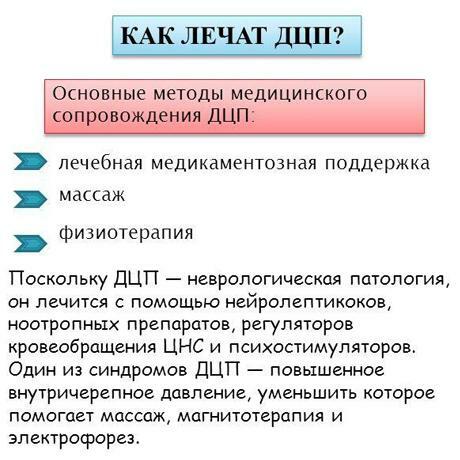
Basic methods of treatment of cerebral palsy
Diagnosis of cerebral palsy is a difficult test for parents, but this disease is not a verdict at all. The possibilities of modern medicine, combined with regular treatment and rehabilitation measures, can significantly improve a child's quality of life, and sometimes give him the opportunity to lead a normal life.


